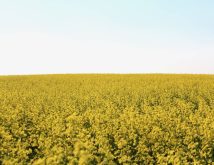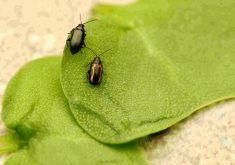A new biological control strategy could be a game changer in the battle against blackleg in canola.
The fungal infection that has a yield-destroying effect on canola crops was first discovered in Saskatchewan in 1975 and eventually spread across the country.
Blackleg is the result of the interaction between two closely related fungal species, Leptosphaeria maculans and the less virulent Leptosphaeria biglobosa.
Read Also

Manitoba boosts stake in cereals centre to $23.5 million
Premier Wab Kinew said the additional project funds will help ‘Trump-proof’ the provincial economy.
In the 1990s, resistant strains were developed that did a good job of controlling the disease, but with blackleg yield losses once again on the rise, researchers are looking at new and creative approaches to fight it.
A recently published paper by University of Manitoba plant pathologist Dilantha Fernando, co-authored by Rasanine Padmathilake, flips the script on how these two fungal species interact.

“The L. maculans, which is the virulent strain, is predominantly found early in the season,” Fernando says. “L. bigloboso, which is the less virulent strain, comes along later in the season.”
It’s similar to Robert Jenner’s suspicion, in the 1790s, that less-virulent cowpox protected milk maids from the more-virulent small pox, leading to the first immunizations against disease.
[RELATED] Grainews: Blackleg is still a threat for canola
Research done at the University of Manitoba in the early 2000s showed inoculation with the less virulent strain can boost the resistance of canola plants against the highly virulent strain. Fernando’s team set up lab and greenhouse trials to confirm the effectiveness of L. biglobosa as a biocontrol agent against L. maculans.
The trials began by creating isolates of both fungal species in the lab. In the greenhouse, they had several plants at the cotyledon stage. They infected those plants with the two strains at different intervals and compared the results four days after infection. Those results were promising. Plants first treated with the L. bigloboso species showed resistance to L. maculans, and it happened quickly.

“The triggering of defence genes takes place within hours,” says Fernando. “And it is not the isolate itself that is doing the work. The plant’s defence mechanisms are being triggered by the less virulent strains.”
In other words, the less virulent isolate immunizes the plant against the more virulent strain, similar to the way a vaccine works.
“The defence pathways are expressed because of the resistant gene, and it’s the same principle here,” says Fernando. But instead of resistance being created in a lab, the plant creates its own.
The trick is to develop a product and delivery technique that are practical for use on the farm.
Timing of the application is critical. Blackleg is basically in the stubble of every canola field so beating the L. maculans to the punch is not easy.
“On the applied side, the farmer must be able to capture and inoculate with the less virulent strain at those very early stages of the crop,” Fernando says.
That’s one more thing on the farmer’s to-do list, and it has a hard deadline, which could stymie farmer uptake. Further development will require investment from the private sector, which could also be a roadblock to development.
But Fernando says there is hope because of recent seed treatments. Products like Syngenta’s Saltro protect against blackleg and slow the infection in its initial stages. Fernando says using a seed treatment like that could buy the farmer some much-needed time to apply an L. bigloboso treatment before L. maculans starts to dominate.
[VIDEO] Below, Dane Froese with Manitoba Agriculture offers a quick explainer on why ‘matching the puzzle piece’ is essential to keeping blackleg in check and reveals how growers can unearth the canola genes that will offer the best blackleg resistance in their fields.
Fernando says he can’t speculate on what a farm-ready product might look like, but he did say certain characteristics would have to be considered. One of the tricky aspects of dealing with a biological entity is keeping it alive.
“You would need the inoculum to have a fairly good shelf life so the spores do not disintegrate and become non-viable,” says Fernando.
Companies might consider an adjuvant or a mechanism that would make the inoculant stick to the plant more effectively than a regular spore, he added.
But the most crucial consideration is timing.
“We already know the timing of L. maculans, but what is required is to see whether we can beat that period by enough to trigger the defence genes,” says Fernando. “Then the plant will take care of itself.”
















